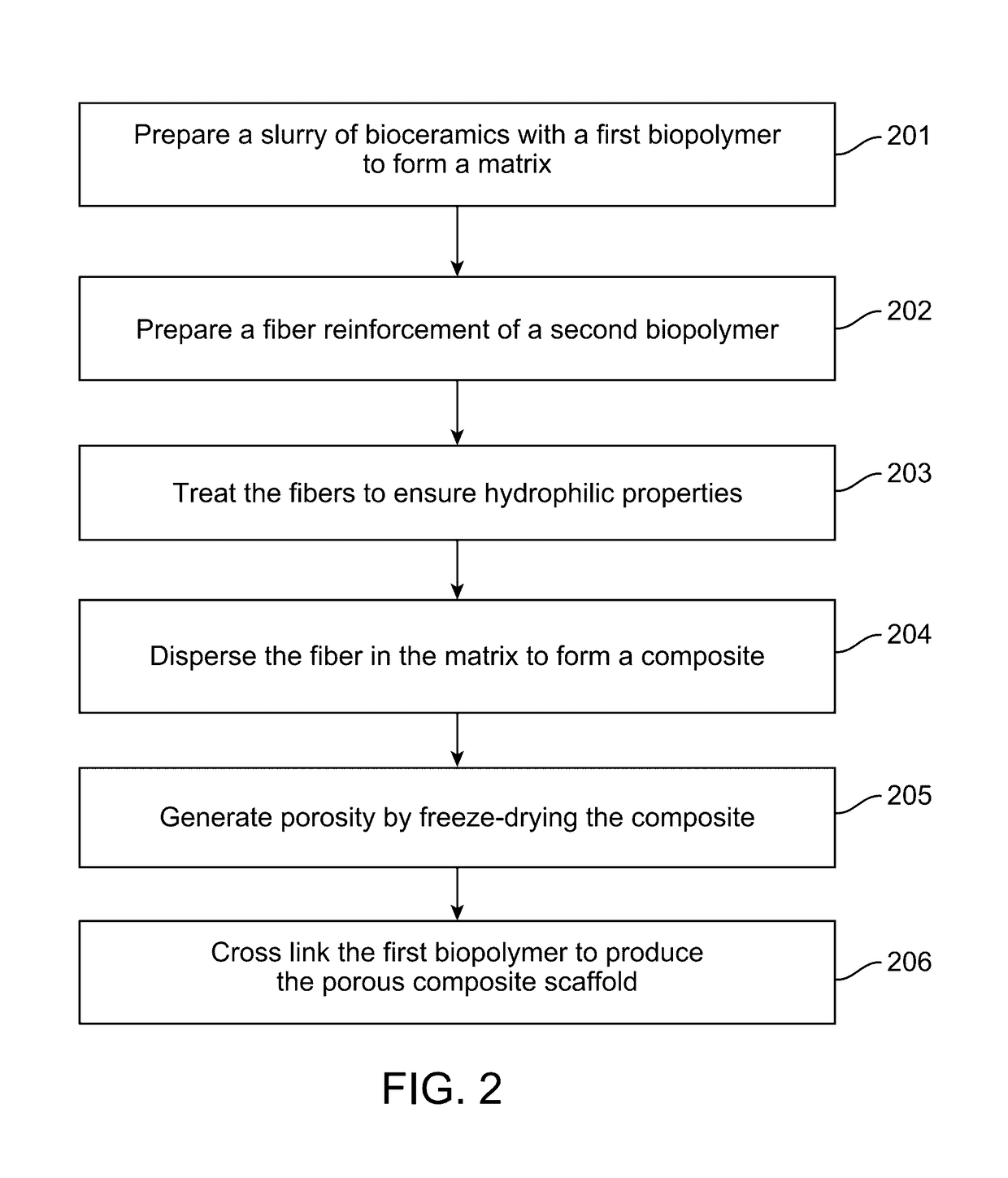Porous composite fibrous scaffold for bone tissue regeneration
a composite fibrous and bone tissue technology, applied in tissue regeneration, medical science, prosthesis, etc., can solve the problems of site morbidity of autografts, immunological response, unsuitable load-bearing applications,
- Summary
- Abstract
- Description
- Claims
- Application Information
AI Technical Summary
Benefits of technology
Problems solved by technology
Method used
Image
Examples
example 1
Development of Electrospun Yarn Reinforced Gelatin-silica Coated HA Matrix
[0052]Skeletal bones comprise mainly of collagen fibrils and carbonate substituted HA (35:65 ratio). These composites behave mechanically in a superior way to the individual components. Collagen fibrils constitute 90% of the organic phase of bone and are largely responsible for increasing fracture toughness and for providing resilience to bone. Calcium and phosphate in the form of HA is responsible for its stiffness and strength. In addition, trace elements like silica, strontium, zinc etc. have been shown to have positive effect on bone regeneration. Thus, a biomaterial engineered from such components is likely to behave similarly to native bone. In view of the above, a porous 3D scaffold made of gelatin-silica coated HA composite was developed, which was reinforced with electrospun fibrous yarns for bone tissue regeneration.
[0053]Electrospun micro / nano fibers of poly (L-lactic acid) (PLLA) were developed in ...
example 2
Characteristics of the Composite Fibrous Scaffold
[0056]Scanning electron micrographs of electrospun yarns reinforced gelatin-HA composite scaffold are shown in FIGS. 4A-4B. The material was porous in nature with pores size in range of 50-500 μm. The fibrous yarns were well dispersed in gelatin-HA matrix in a random manner.
[0057]Porosity evaluation of composite scaffolds is shown in FIG. 5. Electrospun yarns were incorporated in three weight percentages (5, 10 and 15 wt %) to know whether fiber incorporation is having any impact on porosity. FIG. 5A and 5B show the micro CT 3D view of composite scaffolds (without fiber in FIG. 5A and with fibers in FIG. 5B). FIG. 5C shows the mercury porosimetric evaluation of scaffolds. Scaffold without fiber, scaffold with 5 wt % fibers, scaffold with 10 wt % fibers; scaffold with 15 wt % fibers are represented by CF(-),CFS, CF10, and CF15 respectively. All the scaffolds displayed porosity in the range of 60-75%, which is optimal for bone regenerat...
example 3
[0058]Mechanical strength analysis of composite scaffold with and without fibers is shown in FIG. 6A to FIG. 6D. FIG. 6A presents flexural strength data of the composite fibrous scaffold, FIG. 6B represents toughness (work of fracture) data, FIG. 6C represents load vs. extension curves and FIG. 6D illustrates flexural modulus data of the composite scaffold with varying content of reinforcing fibers. Electrospun yarns were incorporated in three weight percentages (5, 10 and 15 wt %). As observed in FIG. 6A-6D, the strength together with toughness was increased with increase in the weight percentage of fibers. Scaffold without fiber, scaffold with 5 wt % fibers, scaffold with 10 wt % fibers; scaffold with 15 wt % fibers are represented by CF(-), CF5, CF10, and CF15 respectively in the figures.
[0059]The adherence of mesenchymal stem cells on composite scaffolds after 24 h is shown in FIG. 7A-7D. The scaffold without fiber is represented by CF(-) and the scaffold with 10 wt % fibers is ...
PUM
| Property | Measurement | Unit |
|---|---|---|
| flexural modulus | aaaaa | aaaaa |
| flexural modulus | aaaaa | aaaaa |
| pore size | aaaaa | aaaaa |
Abstract
Description
Claims
Application Information
 Login to View More
Login to View More - R&D
- Intellectual Property
- Life Sciences
- Materials
- Tech Scout
- Unparalleled Data Quality
- Higher Quality Content
- 60% Fewer Hallucinations
Browse by: Latest US Patents, China's latest patents, Technical Efficacy Thesaurus, Application Domain, Technology Topic, Popular Technical Reports.
© 2025 PatSnap. All rights reserved.Legal|Privacy policy|Modern Slavery Act Transparency Statement|Sitemap|About US| Contact US: help@patsnap.com



